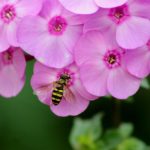Over 70% of plant species rely on animals or insects for pollination. These plants and trees need the ability to attract animals or insects to do their pollinating. Much effort is put into producing enticing flowers and/or scent in order to attract the pollinators, while much less effort goes into producing the small amount of necessary pollen. Insect pollination is more direct and efficient as compared to wind pollinated plants, but attracting pollinators is quite costly in plant energy.
Although bats commonly pollinate plants such as bananas, guava and mangoes in the temperate zone, much more common in our area is insect pollination, called ‘Entomophily’. Quietly observing a meadow or garden of flowering plants for even a few minutes on a warm sunny day will allow you to view many different insects in their search for flowers. The large meadow by the Maintenance building is often bypassed, but it’s a short walk providing so much activity. You are likely to observe bees and wasps Hymenoptera, flies Diptera, butterflies and moths Lepidoptera and perhaps beetles Coleoptera. These are our area’s chief insect pollinators, in order of our most common to least common.

While pollination is quite a broad topic, I thought I’d grab my camera and head to Tyler to see what activity I could observe. I didn’t expect to see any animals pollinating, although it’s fascinating to watch the Ruby-Throated Hummingbirds visiting the dozens of Cardinal flowers, Lobelia cardinalis, along the Native Woodland Walk now and into September.

In spring, I came to the red horse chestnut tree (Aesculus X), and quietly watched the bees visiting the long tubular flowers. As we often note, a bee may skip over some flowers and spend more time at other flowers. Once an individual flower on this tree is pollinated, it no longer produces nectar and the yellowish flowers become pinker in color. The bee will seek out the younger, yellower flowers knowing the nectar will be found there. This is efficient for the bee, and leads to greater visits to the young fertile flowers, resulting in a better chance for pollination.
Also close by, the hornbeam maple (Acer carpinifolium) displayed many long flower clusters called racemes. The flowers at the base of the raceme were open, with flower buds evident at the ends. There were quite a few bees with pollen filled baskets on their legs and they seemed to spend a lot of time at each flower.

Each subsequent visit to Tyler had me observing the various shapes, markings and colors of the flowers along with the insect activity. The co-dependence was evident. While my visits provided learning opportunities, I was reminded that there is so much we miss as we walk through the arboretum. I’ve pulled together some fun facts below:
- Since insects don’t fly in rainy weather, many flowers save energy and don’t bother to open.
- The location of nectar on flowers is not always obvious, and the flowers often contain visual clues to guide the insects to the nectar. These nectar guides can be spots, lines, dots or figures of a color different from the flower as a whole. The insect follows the guide to reach the nectar. Think of the yellow ring at the center of the forget-me-knot, Myosotis, or the spots on the throat of the foxglove, Digitalis.
- Magnolias existed long before winged insects came into being. Magnolias are pollinated by beetles.
- Paw paw trees, Asimina triloba, produce flowers which contain both male and female reproduction parts, but the pollen and stigma mature at different times. This requires cross pollination by another unrelated tree in very close proximity, and is performed by flies and beetles who don’t travel far.
- The 700+ varieties of figs, Ficus carica have co-evolved with their only pollinator, a specialized fig wasp. Each of the 900+ species of fig wasps pollinate just one or two varieties of fig. The fig is actually not a fruit, but a cluster of enclosed flowers. The fig wasp burrows into the fig to these flowers to lay eggs and in so doing, leaves behind pollen.

Now that it is mid summer, it’s interesting to go back and check for signs of successful pollination. The seeds are obvious on the red horse chestnut, but not nearly as many as may have been expected based on the number of flowers. The Hornbeam maple displays many seeds which are called ‘samaras’, although many of us use the term from our childhood, helicopters. The paw paw trees on the Native Woodland walk have about ten visible fruit. There is still so much pollinating to observe, so don’t miss the opportunity to watch pollination in action as you visit the meadows, perennial borders and the edible garden throughout the summer and fall.
Further Reading
Pollinator Syndrome: https://www.fs.usda.gov/managing-land/wildflowers/pollinators/syndromes






